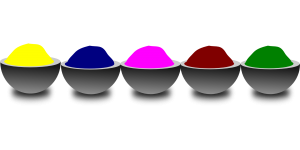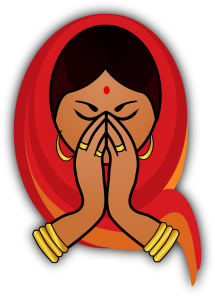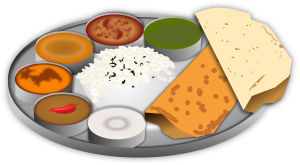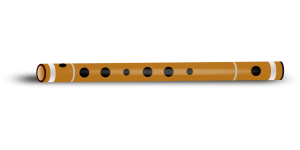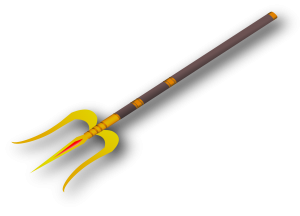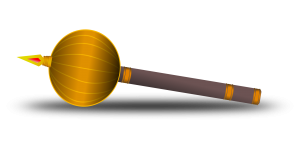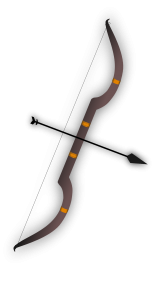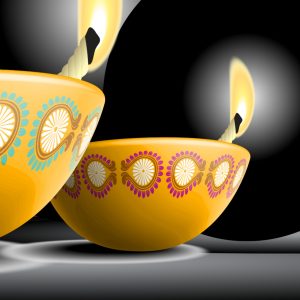
Once there was a barber who was going here and there giving out invitations. In previous times barbers performed this task for families. If there was to be a marriage or a festival, he would go and distribute the invitations to everyone, and for doing this he would earn a little extra money. But he would not go anywhere without his instruments such as a razor, scissors and a comb.
Starting on his way, this barber entered a jungle where he saw a lion resting on the path. The lion did not attack him, but instead was merely lifting up its paw and licking it. At first the barber was frightened, but then he thought, “It seems that there is something stuck in his foot, and that is why he is not attacking.” So the barber went a little nearer and saw that a very large thorn was stuck in very deeply, and due to this the lion was suffering greatly. Therefore, with the help of his instruments, the barber manipulated the thorn a little and carefully removed it. Some blood had been coming from the wound, so he also applied some antiseptic, wrapped the lion’s paw in some medicinal leaves, and then left.
Three or four years went by. Then one day that same barber was mistakenly arrested for some very serious crime such as murder. His case was brought before the king, who said, “Several days ago in the jungle we captured a lion.
Throw the criminal into the lion’s compartment. The lion will eat him – finished. For him there can be no other punishment. Throw him in!”
The barber was thrown into the lion’s cage, and at once the lion got up, roaring. But as he came near the barber, he began to purr and sat down. This was the same lion from which the barber had removed the thorn, and after so many years the lion recognised the barber and therefore did not attack him. The king said, “This fierce animal is not attacking him? What is this?” Then he thought, “Now I understand. Because I have made a mistake in arresting this man, the lion is not killing him. If the lion is not carrying out this punishment, then I also should not punish him.” The king released the barber, showed him respect and asked for forgiveness.
Even in an animal there is so much gratitude, and Kṛṣṇadāsa Kavirāja Gosvāmī says that Nityānanda Prabhu’s gratitude is just like this. For one minute that barber removed a thorn from the lion, and for so many years the lion remained grateful. That animal, which is so fierce that it kills innumerable other animals and people also, remained grateful for its entire life, and we see the same quality of gratitude in the life of Nityānanda Prabhu.
In Śrī Caitanya-caritāmṛta, Kṛṣṇadāsa Kavirāja Gosvāmī gives an example of how Nityānanda Prabhu, being Bhagavān Himself, is merciful to someone. He says that on one occasion there was to be a festival with kīrtana going on continuously all day and night. Vaiṣṇavas who lived both nearby and far away were invited, and they all came. Amongst them was an eternal associate of Nityānanda Prabhu named Mīnaketana Rāmadāsa. His nature was such that his mercy could not be easily recognised, but those who understood him could see it. Generally, if some dear person comes, one offers praṇāma. But instead he would hit someone with the flute which he always kept in his hand, and that person would understand it to be great mercy. When he would place his foot on the head of someone, they would consider that there would be good fortune in their lives from that day on. Sometimes he would slap someone and say, “Where have you been all these days?” But those who understood knew that, “Whoever he has struck today will receive the direct mercy of Nityānanda Prabhu.” So the kīrtana was going on, and when Mīnaketana Rāmadāsa came, everyone stood up, offered praṇāma to him, and welcomed him. He climbed on the shoulders of one person, hit another with his flute, and slapped another on the back. Tears were always flowing from his eyes, and he was always roaring out, “Nityānanda Prabhu kī jaya!”
The pūjārī there was somewhat educated, and when Mīnaketana Rāmadāsa entered, while everyone else had stood and offered praṇāma, this pūjārī didn’t stand, and he also wouldn’t speak to him. So, laughing, Mīnaketana Rāmadāsa said, “Here we find the second Romaharṣaṇa*!”, and then he became absorbed in singing the glories of Nityānanda Prabhu. Everyone performed very loud kīrtana, and when it was finished, Kavirāja Gosvāmī’s brother said, “You are always singing about the glories of Nityānanda Prabhu, but why don’t you sing the glories of Caitanya Mahāprabhu instead?” Hearing this, Mīnaketana Rāmadāsa became somewhat unhappy.
That man considered that there was some difference between Nityānanda Prabhu and Caitanya Mahāprabhu. But there are so many stories and glories of Nityānanda Prabhu, and they are all related to Caitanya Mahāprabhu. If someone is singing the glories of Śrīmatī Rādhikā, then are they not also singing the glories of Kṛṣṇa? Rādhikā is the dearmost of all to Kṛṣṇa, and Her service is the best of all. In singing the glories of Rādhikā, one must necessarily be glorifying Kṛṣṇa. And similarly, if someone is describing the glories of Caitanya Mahāprabhu, in doing so they cannot but be glorifying Śrī Rādhā and Kṛṣṇa.
Kavirāja Gosvāmī’s brother continued, “Such a person you are: all the time chanting ‘Nityānanda, Nityānanda,’ and not glorifying Mahāprabhu. Always ‘Nityānanda, Nityānanda,’ but he married, whereas Mahāprabhu took sannyāsa, leaving His home and family.”
Hearing this, Mīnaketana Rāmadāsa broke his flute and left that place. He was so unhappy that he broke his dearmost possession and left. At that time Kavirāja Gosvāmī thought to himself, “Now something inauspicious will certainly happen to my brother. How can there be any auspiciousness in his life after this?”
Gradually everything was destroyed for his brother. What do we mean by “destroyed”? His bhakti disappeared. By the mercy of saints one obtains bhakti, but if those saints are displeased, will our interest in bhakti remain? No. Everything was destroyed for him and he became an atheist, so Kavirāja Gosvāmī thought, “I will not keep company with such an atheist. I no longer consider him my brother. If one is not favourable towards kṛṣṇa-bhakti, then a friend is not a friend, a mother is not a mother, a father is not a father, and a relative is not a relative. I will not have any contact with him at all.” Later that very night, at about three or four o’clock, he made the decision to leave, and very unhappily he went away from there.
Arriving at Jhamatpur village, Kavirāja Gosvāmī sat down to rest and began thinking, “I cannot stay here. Where will I go?” While thinking over his situation, he dozed off. Then Nityānanda Prabhu appeared to him in a dream. In his hand was a golden stick. His form was very large and had a glossy, dark lustre. He had an earring in one ear, and his beauty was marvellous, just like Baladeva’s in kṛṣṇa-līlā. He said, “Why are you crying? Why are you upset? Get up, get up! Go to Vṛndāvana! And there place the feet of Rūpa and Sanātana on your head. Go! You left your brother for me? I am very pleased with you. A real brother is one who can give bhakti, a father is one who can give instructions regarding bhakti, and a mother is one who can inspire kṛṣṇa-bhakti. Your dear brother insulted me a little, and for that you left him forever? I am very pleased. Go to Vṛndāvana. There you will receive darśana of Govinda, Madana-mohana and Gopīnātha. You will receive the mercy of Rūpa and Sanātana, and also the mercy of Vṛndāvana-dhāma itself. Go!”
So Kavirāja Gosvāmī has written, “All I did was leave my brother, and for that Nityānanda Prabhu gave me such immense mercy! By that mercy, I have obtained darśana of Vṛndāvana-dhāma.”
What kind of darśana did he obtain – like ours? This is the kind of darśana he received: he saw Kṛṣṇa taking the cows out to graze, the gopīs looking for Kṛṣṇa with thirsty eyes, and the līlā of Śrī Rādhā and Kṛṣṇa. And what is the meaning of the mercy of Rūpa and Sanātana? By Sanātana’s mercy Kavirāja Gosvāmī obtained sambandha-jñāna and scriptural knowledge, but even when one possesses this knowledge, there still may not be rasa. By the mercy of Rūpa Gosvāmī he obtained the knowledge of rasa, and then he could compose such books as Śrī Caitanya-caritāmṛta and Govinda-līlāmṛta, wherein so much rasa is described. The mercy of Rūpa Gosvāmī has made all this possible.
In this world, even an animal will remain indebted for its entire life to someone who removes a thorn from it. In the same way, we are indebted to our guru and the Vaiṣṇavas. How can we be ungrateful to those who have tried to remove the thorn of material attachment from us, and have tried to entice us to drink bhakti-rasa? Towards such gurus and Vaiṣṇavas we should always be grateful. If on one day gurudeva is a little harsh with us and in one minute we become ungrateful, thinking, “Oh, he no longer has affection for me,” what ill fortune that is. We will always remain indebted to gurudeva and the Vaiṣṇavas, and we can never repay this debt. If one doesn’t understand this statement of Kṛṣṇadāsa Kavirāja, then that is his great misfortune; but one who understands this will never forget his indebtedness for his whole life. Even upon dying, he won’t forget it, and then again in his next birth he will remember.
This gratitude is one of the main qualities of Bhagavān himself. Although Nityānanda Prabhu is Bhagavān himself, he becomes indebted to someone in the same way as Kṛṣṇa became indebted to the gopīs:
na pāraye ’haṁ niravadya-saṁyujāṁ
sva-sādhu-kṛtyaṁ vibudhāyuṣāpi vaḥ
yā mābhajan durjara-geha-śṛṅkhalāḥ
saṁvṛścya tad vaḥ pratiyātu sādhunā
Śrīmad-Bhāgavatam (10.32.22)
Even within a long lifetime like that of the demigods I would be unable to repay you, because you have all left your homes and families to serve Me. Therefore please let your own glorious deeds be your compensation.
Similarly Nityānanda Prabhu says, “He has broken out of the shackles of material attachment and come to engage in my service. He doesn’t care at all for worldly life. Can I ever leave those who have left their family, money and property to take up bhajana? I will never be able to.” Kavirāja Gosvāmī has also written:
saṅkarṣaṇaḥ kāraṇa-toya-śāyī
garbhoda-śāyī ca payobdhi-śāyī
śeṣaś ca yasyāṁśa-kalāḥ sa nityā-
nandākhya-rāmaḥ śaraṇaṁ mamāstu
Śrī Caitanya-caritāmṛta (Ādi-līlā 5.7)
May Śrī Nityānanda Prabhu be my shelter. Saṅkarṣaṇa, Śeṣanāga, Kāraṇodakaśāyī Viṣṇu, Garbhodakaśāyī Viṣṇu and Kṣīrodakaśāyī Viṣṇu are His plenary portions and the portions of His plenary portions.
In Vaikuṇṭha there are different sections on the same level, and other sections that are on higher levels. Incarnations such as Nṛsiṁha, Kalki and Vāmana are on the same level in Vaikuṇṭha-dhāma. They share the same “floor” but have their own special chambers. The lowest point is the Virajā, then above that is Siddhaloka, which is known as the outside part of Vaikuṇṭha. Those enemies that are killed by Bhagavān are awarded that destination. Siddhaloka is also for those who chant ahaṁ brahmāsmi, thinking that the jīva ultimately merges into Brahman. But the jīvas cannot lose their individuality. That they ultimately become one is such a lie. Yes, they meet together, just as devotees meet together and share hari-kathā. As Kṛṣṇa comes together with the gopīs, gopas, Yaśodā and Nanda Bābā, and as Rāmacandra comes together with Hanumān – this meeting and coming together is done, but meeting and becoming one? Nowhere can such an example be found. Meeting, yes – but they will remain individual. The jīva never becomes Brahman. Many renowned paṇḍitas and scholars hold this theory and thousands of people come to hear their lectures. They say that there is nothing equal to kṛṣṇa-bhakti and that the bhakti of the gopīs is the best of all, and that anyone who attains devotion like that of the gopīs becomes one with Brahman. This type of hari-kathā is completely useless. They are deceiving people, and therefore we should not attend any functions where they say that we will become one with Rādhā-Kṛṣṇa.
Above Siddhaloka is Sadāśivaloka, and above that is Nārāyaṇa-dhāma, where the liberated four-armed devotees reside. Sālokya, sāmīpya, sārūpya and sārṣṭi – the devotees there possess these four kinds of liberation and remain near to Nārāyaṇa serving him in aiśvarya-bhāva, the mood of opulence. Nearby are millions of special chambers, and in them are Varāha, Nṛsiṁha, Kalki and all the other incarnations. When there is a necessity, they come to this world; otherwise they remain there all of the time, accepting service from their devotees. Above that is the world of Rāmacandra and above that is the world of Kṛṣṇa, which is known as Goloka. In calling this Goloka, there may be some confusion, so I will try to clarify it a little.
When Indra was performing the abhiṣeka of Kṛṣṇa, he brought Surabhi there. So the residence of Surabhi is Goloka, isn’t it? But don’t think that Indra brought her from Goloka Vṛndāvana. In this brahmāṇḍa, and each and every brahmāṇḍa, there is Hariloka, the residence of Kṣīrodakaśāyī Viṣṇu. The demigods cannot directly have Viṣṇu’s darśana, but sometimes in his meditation Brahmā receives his darśana and attains the power to create and the strength to protect the world. In this way each brahmāṇḍa has its own Goloka, and this is also called Surabhiloka or Śvetadvīpa. Indra can travel up to there, and he brought Surabhi from there, saying, “You are go-mātā, so please pray to Kṛṣṇa for me.”
Therefore this Goloka and Goloka Vṛndāvana are not one and the same. Similarly, the Navadvīpa-dhāma that is situated in the spiritual world is also known as Śvetadvīpa, but it is separate from the Śvetadvīpa included within this brahmāṇḍa wherein Kṣīrodakaśāyī Viṣṇu resides.
The lower section of Goloka-dhāma, below Dvārakā, is where there is svakīya-bhāva. Pastimes of Rādhā-Kṛṣṇa take place there, but there Rādhā-Kṛṣṇa are like extensions of Lakṣmī-Nārāyaṇa in the mood of opulence. This is the destination of those who perform arcana of Rādhā-Kṛṣṇa by vaidhī-bhakti. Those who perform arcana of Rādhā-Kṛṣṇa by vaidhī-bhakti combined with rāgānugā sentiments go to either Mathurā or Dvārakā. And those who have “greed” and fully follow rāgānugā in its pure form go to Goloka Vṛndāvana. That realm is in the shape of a lotus flower, and the centre of that lotus is the home of Nanda. Devotees who are fully absorbed in rāgānuga-bhakti attain positions there in the pastimes of Kṛṣṇa, either accompanying Kṛṣṇa as He takes the cows out to graze or as friends of Rādhikā. This is the highest attainment.
There Kṛṣṇa is known as Vṛndāvana-bihārī, Govinda, Śyāmasundara and Gopīnātha, and His first extension is Baladeva. Kṛṣṇa’s stick, the peacock feather in Kṛṣṇa’s crown, all of Kṛṣṇa’s paraphernalia, the gopīs’ paraphernalia, Vṛndāvana-dhāma – all of these are manifest by sandhinī-śakti, and the embodiment of that potency is Baladeva Prabhu. The embodiment of hlādinī-śakti is Rādhikā, and Kṛṣṇa is the possessor of cit-śakti. These three together are sac-cid-ānanda, the complete form of Kṛṣṇa. Neither Rādhikā nor Baladeva are separate from Him; together they are one.
From Baladeva Prabhu alone all the eternally perfected devotees of Kṛṣṇa are manifest. When Kṛṣṇa goes to Dvārakā, He becomes Vāsudeva, the son of Vasudeva. And in Dvārakā, Baladeva also feels that he is the son of Devakī, but in his original identity he is the son of Rohiṇī, and ultimately Nanda Bābā is Baladeva’s father. Not that anyone can actually be the father of Baladeva as there are fathers and sons in this world, but Nanda Bābā has the identity of being his father. Nanda Bābā has the strongest identity of being the father of both Kṛṣṇa and Baladeva – ordinary, worldly scholars cannot accept this point. They cannot understand that in whomever the identity of being Kṛṣṇa’s father is the most intense, that person is ultimately considered to be His father. Mostly they propound that Kṛṣṇa is the son of Vasudeva and very few of them accept that He is really Nanda-nandana.
Thus Baladeva Prabhu is the vaibhava-prakāśa of Kṛṣṇa, and he renders service to Kṛṣṇa all the time. Service to Kṛṣṇa is his everything, whether it is in Vṛndāvana, Mathurā or Dvārakā. When they go to Mathurā and Dvārakā, taking non-different forms, they become the first catur-vyūha: Vāsudeva, Saṇkarṣana, Pradyumna and Aniruddha. Then there is a second catur-vyūha, and from the root Saṅkarṣaṇa comes Mahā-Saṅkarṣaṇa. From Mahā-Saṅkarṣaṇa comes Kāraṇodakaśāyī Viṣṇu, from Kāraṇodakaśāyī comes Garbhodakaśāyī, and Garbhodakaśāyī becomes Kṣīrodakaśāyī. Kṣīrodakaśāyī Viṣṇu then expands into countless forms as the witness in the hearts of all living beings, Paramātmā. In our hearts, as the witness, is that very Baladeva in his vyasti (expansion) as the antaryāmī Kṣīrodakaśāyī. Kṣīra means milk, and just as our mother nourishes us by feeding us milk, he also sustains and nurtures us.
Near Kṣīrodakaśāyī Viṣṇu are Brahmā and Śaṇkara, and by his desire and power, creation and destruction of the material universes take place. As Śeṣanāga he has millions and millions of heads, and he is holding millions and millions of universes on his heads as if they were mustard seeds, while also taking the form of the beds on which all three puruṣa-avatāras lie. These are the six kinds of expansions of Baladeva Prabhu: from his original form in Vṛndāvana comes the root Saṅkarṣaṇa in Mathurā and Dvārakā, then Mahā-Saṅkarṣaṇa in Vaikuṇṭha, then Kāraṇodakaśāyī Viṣṇu, Garbhodakaśāyī Viṣṇu, Kṣīrodakaśāyī Viṣṇu and finally Śeṣa. One who knows these deep truths will never again have to enter the cycle of birth and death.
The puruṣa-avatāra is called puruṣa because he is related to the creation of the material world. He comes into contact with māyā indirectly for the purpose of creation and management, but he himself remains separate from it. Yes, he is inside all souls, but at the same time he is within no one. He does everything, and he inspires others to do everything, but simultaneously he does nothing. Therefore he is called a puruṣa-avatāra. From this puruṣa-avatāra come the manvantara-avatāras, yuga-avatāras and so many other incarnations. They come from Kāraṇodakaśāyī Viṣṇu or from Garbhodakaśāyī Viṣṇu, who can also be called avatārī, meaning that from them avatāras come forth.
When Kṛṣṇa comes to this world in any of His forms, then in the form of the dhāma and eternal associates, Baladeva Prabhu will certainly come also. Before Kṛṣṇa descends to perform pastimes in Vṛndāvana, Baladeva enters into the heart of Devakī and is present in her womb in the form of Saṅkarṣana; then Kṛṣṇa Himself can manifest. Therefore Baladeva comes first in the form of the dhāma and serves Kṛṣṇa in that way.
If someone says that Kṛṣṇa is an incarnation of Kāraṇodakaśāyī and someone else says that He is an incarnation of Garbhodakaśāyī, it will cause unnecessary confusion. In some places you will find such descriptions. Or sometimes Kṛṣṇa is described as being born from the hair of Nara-Nārāyaṇa – Keśa-avatāra, an incarnation of Nara-Nārāyaṇa. We may find such statements, but actually:
ete cāṁśa-kalāḥ puṁsaḥ
kṛṣṇas tu bhagavān svayam
Śrīmad-Bhāgavatam (1.3.28)
All the incarnations of Bhagavān are either plenary portions or parts of plenary portions of the puruṣa-avatāras. But Kṛṣṇa is Svayam Bhagavān Himself.
When it is said that Kṛṣṇa Himself is an incarnation, it is like a simple old lady who gives a blessing to the prime minister by saying, “My son, may you one day become the police commissioner.” In her understanding, that is the highest post of all. The lady has said this with love, but she doesn’t understand which position is higher. Similarly, some say that Kṛṣṇa is an incarnation of Garbhodakaśāyī or Kṣīrodakaśāyī Viṣṇu.
When Śrī Rāmacandra descended, Baladeva came as Lakṣmaṇa. Rāmacandra’s pastimes are so full of separation and self-sacrifice that they make everyone cry. For apparently no reason, he deserted Sītā-devī, not only once, but twice. Lakṣmaṇa had not wanted Rāma to go to the forest, and therefore, while they were exiled, he said to Rāma, “I no longer consider Mahārāja Daśaratha to be our father. Being excessively lusty, he is controlled by a woman; and in his old age his intelligence has diminished. I should kill him! Look – someone is coming! If it is Bharata, I will kill him also!”
Bharata was coming to appease Rāma, but when Lakṣmaṇa climbed up a tree and saw the armies, he became very angry. Taking his bow and arrow, he started towards them. “Where are you going?” Rāma asked. “With whom will you fight?”
Lakṣmaṇa said, “Bharata has come with great pride. He wants to remove you so there will be no obstacle to him becoming the king! Therefore I am going now, and with one arrow I will finish them all!”
 But Rāma was thinking that there was a misunderstanding, so he told Lakṣmaṇa a story. Once there was a woman who raised a mongoose for the purpose of protecting her household from snakes. Each day, she put her children to sleep on the bed and, placing the mongoose nearby, went out. One day, while she was out, a snake came desiring to bite the children. The mongoose had a great fight with the snake, and with great difficulty the mongoose killed it and protected the children. Then, being pleased with itself, the mongoose was waiting outside the house for its mistress, and there was still some blood on its mouth from the fight. The woman returned, and the mongoose went before her, saying “ku-ku-ku”. The woman said, “Where has this blood come from? You attacked the children and harmed them?” Hastily, she picked up a stick and killed the mongoose. Then she went inside the house and saw the children playing; the dead snake was laying nearby. Realising her mistake, she lamented.
But Rāma was thinking that there was a misunderstanding, so he told Lakṣmaṇa a story. Once there was a woman who raised a mongoose for the purpose of protecting her household from snakes. Each day, she put her children to sleep on the bed and, placing the mongoose nearby, went out. One day, while she was out, a snake came desiring to bite the children. The mongoose had a great fight with the snake, and with great difficulty the mongoose killed it and protected the children. Then, being pleased with itself, the mongoose was waiting outside the house for its mistress, and there was still some blood on its mouth from the fight. The woman returned, and the mongoose went before her, saying “ku-ku-ku”. The woman said, “Where has this blood come from? You attacked the children and harmed them?” Hastily, she picked up a stick and killed the mongoose. Then she went inside the house and saw the children playing; the dead snake was laying nearby. Realising her mistake, she lamented.
So Rāma said to Lakṣmaṇa, “Your condition is exactly like this. First wait and see; let Bharata come. Even the Earth herself can be selfish, but Bharata can never be selfish. Nowhere in this world is there an emblem of love like Bharata. So let him come.”
When Bharata came, he fell at the feet of Rāma and began to appease him. Seeing him offering praṇāma to Rāma, Lakṣmaṇa realised his mistake. When Bharata was leaving, Lakṣmaṇa approached him alone and fell at his feet. As Bharata lifted him up and embraced him, Lakṣmaṇa said, “I am a great offender at your feet. I have not been able to be affectionate to you, to love you,” and he began weeping bitterly.
Another time during the period when they were living in the forest, Rāma ordered Lakṣmaṇa to bring wood when Sītā desired to enter the fire. Lakṣmaṇa became very angry, but Rāma said, “Service rendered in the forest is the highest. You are always a servant.” Lakṣmaṇa accepted the order of Rāma but thought, “I am making a mistake following his order.” So he brought wood, and Sītā-devī entered into the fire. Of course this was a pretext by which the real Sītā came out and the false Sītā disappeared, but still, in the end, Lakṣmaṇa took a vow that, “I will not come again as your younger brother, but only as your older brother. Then things will be different, and you will not be able to treat me like this.”
Therefore in the pastimes of Kṛṣṇa he came as Baladeva, and in the pastimes of Mahāprabhu he came as Nityānanda Prabhu, the older brother both times. So many pastimes could be performed only as an older brother, which from the position of a younger brother would not be possible. If Nityānanda Prabhu were not present, then so many of Mahāprabhu’s pastimes would have remained hidden. He was Mahāprabhu’s servant, His brother and His guru also. How was he Mahāprabhu’s guru? Mahāprabhu’s guru was Īśvara Purī, the guru of Īśvara Purī was Mādhavendra Purī and the guru of Mādhavendra Purī was Lakṣmīpati Tīrtha. Nityānanda Prabhu was also a disciple of Lakṣmīpati Tīrtha, but because his guru departed from this world when he was at a young age, Nityānanda Prabhu received nearly all of his instruction from Mādhavendra Purī. Whoever gives instruction on bhakti is the representative of Bhagavān, and therefore Nityānanda Prabhu always considered Mādhavendra Purī to be his primary guru. When Mādhavendra Purī became his guru, then Īśvara Purī became his godbrother, and since Nityānanda Prabhu was therefore on the level of Mahāprabhu’s guru, Mahāprabhu respected him in that way.
Although we see that Nityānanda Prabhu had three relationships with Mahāprabhu – as a servant, a brother and a guru– still, Nityānanda Prabhu always considered himself a servant. When Mahāprabhu was absorbed in kīrtana, generally it was Nityānanda Prabhu who protected Him. When Mahāprabhu was dancing in His usual way, Nityānanda Prabhu would catch Him for His own protection, and only when Mahāprabhu became absorbed in rādhā-bhāva could Nityānanda Prabhu not touch Him. Nityānanda Prabhu would engage in all types of service, always following the order of Mahāprabhu. Mahāprabhu told him, “Please go to Bengal! The brāhmaṇas there, being very proud, don’t perform bhajana of Bhagavān. Preach something to the brāhmaṇa class, but mostly preach to those who are considered fallen in society, because they are not really fallen. Each and every soul has the right to perform bhagavad bhajana. Please go.” So Nityānanda Prabhu went there, preached from village to village, and made disciples of everyone.
Once, Nityānanda Prabhu was going along the road with a preaching party when they came across a village where there lived a wealthy landowner named Rāmacandra Khān. Nityānanda Prabhu entered the man’s home and sat down on the altar of the durgā-maṇḍapa. Previously in Bengal the wealthy people would have such maṇḍapas (canopies raised for ceremonial purposes) for Caṇḍī, or Durgā. He was thinking, “Night is falling, so where can we possibly go now? Tomorrow morning we will continue on our way.”
Meanwhile Rāmacandra Khān sent one of his servants to speak to Nityānanda Prabhu. Sarcastically the man said, “There is not enough space for you here in the house, but we have a gośālā which is a very pure place due to the presence of cows and cow dung. Saints and sādhus should stay there, so go to the gośālā.”
When Nityānanda Prabhu heard this, he became angry and said, “Yes, you are right. This place is unfit for 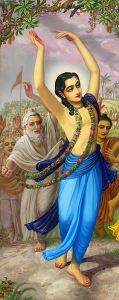 me. It is fit for cow-killing meat-eaters.” Saying this, he left that place. The next day Muslims attacked and arrested Rāmacandra Khān and his entire family. They also killed a cow, cooked the meat and ate it on that very spot. The entire village was destroyed.
me. It is fit for cow-killing meat-eaters.” Saying this, he left that place. The next day Muslims attacked and arrested Rāmacandra Khān and his entire family. They also killed a cow, cooked the meat and ate it on that very spot. The entire village was destroyed.
Nityānanda Prabhu has two aspects, just like a mother lion. To her cubs the lion is very kind, but to others she is very dangerous. Similarly Nityānanda Prabhu is supremely merciful to the devotees and is the subduer of atheists. Just as Baladeva Prabhu holds a plough and club and killed Dvivida gorilla and others who were inimical to Kṛṣṇa, Nityānanda Prabhu subdues the atheists and increases gaura-prema in devotees.
We should never consider there to be any difference between Caitanya Mahāprabhu and Nityānanda Prabhu; there is a difference in body only. Nityānanda Prabhu is the complete guru-tattva, and wherever there is guru, he is there. Wherever the activities of guru are performed, the message of Kṛṣṇa is given to the jīvas that by bhakti only will there be real auspiciousness. This is all manifested by Nityānanda Prabhu. Therefore on this day we offer praṇāma unto he who is the most merciful and the complete gurutattva, and we pray that he will always be merciful to us.
*Romaharṣaṇa is a personality who offended Baladeva Prabhu at a fire sacrifice being performed at Naimisaraṇya, as described in Chapter 78 of the Tenth Canto of Śrīmad-Bhāgavatam.
—Śrīla Bhaktivedānta Nārāyaṇa Mahārāja
Image/Art made possible by Pixabay.com

